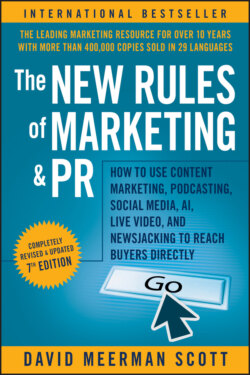Читать книгу The New Rules of Marketing and PR - David Meerman Scott, Kevin Nalty, Steve Garfield - Страница 11
The New Rules
ОглавлениеAt the height of the dot-com boom, I was vice president of marketing at NewsEdge Corporation, a NASDAQ-traded online news distributor with more than $70 million in annual revenue. My multimillion-dollar marketing budget included tens of thousands of dollars per month for a public relations (PR) agency, hundreds of thousands per year for print advertising and glossy brochures, and expensive participation at a dozen trade shows per year. My team put these things on our marketing to-do list, worked like hell to execute, and paid the big bucks for it all because that’s what marketing and PR people did. These efforts made us feel good because we were doing something, but the programs were not producing significant, measurable results. We were working based on the rules of the past.
At the same time, drawing on experience I had gained in my previous position as Asia marketing director for the online division of Knight-Ridder (then one of the largest newspaper and information companies in the world), my team and I quietly created content-based marketing and PR programs on the web.
Against the advice of the PR agency professionals we had on retainer (who insisted that press releases were only for the press), we wrote and sent dozens of releases ourselves. Each time we sent a release, it appeared at online services such as Yahoo! and resulted in sales leads. Even though our advertising agency told us not to put the valuable information “somewhere where competitors could steal it,” we created a monthly newsletter called The Edge, about the exploding world of digital news. We made it freely available on the homepage of our website because it generated interest from buyers, the media, and analysts.
Way back in the 1990s, when web marketing and PR were in their infancy, my team and I ignored the old rules, drawing instead on my online publishing experience, and created a marketing strategy using content to reach buyers directly on the web. The homegrown programs we created at virtually no cost consistently generated more interest from qualified buyers, the media, and analysts—and resulted in more sales—than the big-bucks programs that the “professionals” were running for us. People we never heard of were finding us through search engines. We had discovered a better way to reach buyers.
In 2002, after NewsEdge was sold to the Thomson Corporation (now Thomson Reuters), I started my own business to refine my ideas and teach others through writing, speaking at conferences, and conducting seminars for corporate groups. The objective in all this work was to help others reach buyers directly with web content. Since then, many new forms of online media have burst onto the scene, including social networks like Twitter, Facebook, Instagram, Snapchat, and Pinterest, plus blogs, podcasts, video, and virtual communities. But what all the new web tools and techniques have in common is that they are the best way to communicate directly with your marketplace.
This book actually started as web marketing on my blog more than a decade ago. I published an e-book called The New Rules of PR,1 immediately generating remarkable enthusiasm (and much controversy) among marketers and businesspeople around the world. Since the e-book was published, it has been downloaded several million times and commented on by thousands of readers on my blog and many others. (To those of you who have read and shared the e-book, thank you!) The first edition of this book was much more than just an expansion of that work, because I made its subject marketing and PR and because I included many different forms of online media and incorporated years of additional research.
This book contains much more than just my own ideas, because I blogged the book, section by section, as I wrote the first edition. As I have worked on revisions, including this seventh edition, I’ve continued to blog the stories that appear here. Thousands of you have followed along, and many have contributed to the writing process by offering suggestions through comments on my blog, via Twitter, and by email. Thank you for contributing your ideas. And thank you for arguing with me when I got off track. Your enthusiasm has made the book much better than it would have been if I had written in isolation.
The web has changed not only the rules of marketing and PR, but also the template for business books. The New Rules of Marketing & PR is an interesting example. My online content (the e-book and my blog) led me directly to a print book deal. Other publishers would have freaked out if an author wanted to put parts of his book online (for free!) to solicit ideas. The people at John Wiley & Sons encouraged it. So my thanks go to them as well.
